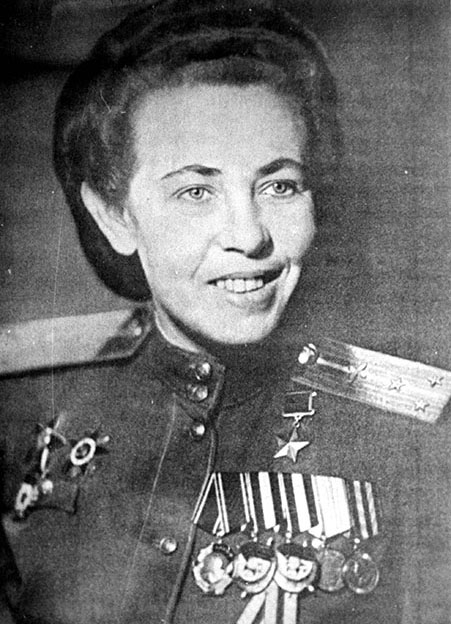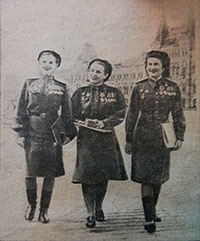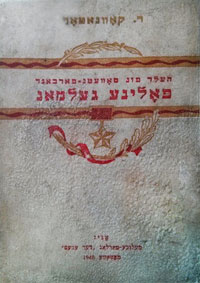Polina Gelman was born in Berdichev, Ukraine in 1919. After the death of her father in 1920, Polina's mother moved the family to Gomel. During her secondary-school years Polina took some flying lessons at the local flying club.
When war broke out on June 22, 1941 Polina was a third-year student in the history department of Moscow State University. In October 1941, when German troops were only 30 kilometers from Moscow, she volunteered for the Red Army. While she was clearly a Soviet patriot, in a letter to her mother Polina stressed her Jewishness as additional reason for her decision to join the war against Nazis: "Mummy, my dear one, I have decided to go to the front. I am a daughter of the Jewish people and I have a particular account [to settle] with Hitler" (GARF 8114-1-182, copy JM/26152).
After some effort she was accepted into Colonel Marina Raskova's recently formed 588th Women's Night-Bombing Air Regiment (one of the three women's regiments formed within the framework of the Soviet Air Force). In October 1943 the regiment was re-named the 46th Taman Guards Night-Bomber Aviation Regiment.
On May 27, 1942, following an intensive three-month course Polina Gelman was assigned to be a navigator of an open light biplane called the U-2, usually used as a training aircraft. The attack tactic of the night bombers that flew at low-altitudes was to idle their engines near German rear-area positions and then glide down to the bomb-release point without revealing their location. German soldiers called these pilots "Nachthexen" ("Night Witches"). As a navigator Polina Gelman showed the way to her fellow-flyers Evdokiia Nosal and, later, Raisa Aronova, dropped bombs on German targets, and returned fire when their plane was fired at by Luftwaffe aircraft. They bombed fuel and ammunition depots in the German rear and front and blew up bridges and German vehicles on their way to the front and assembly places of the Wehrmacht troops. Sometimes they made several sorties in a single night. Polina set a record of 18 sorties in one night. Her crew also supplied Soviet troops in the enemy's rear with supplies, including ammunition and food. In addition they knocked out German searchlights that were searching for Soviet planes and German anti-aircraft gunners, thus inflicting serious damage on the German anti-aircraft effort. Having been a member of the Communist Party since 1942, Polina also served as a political commissar (politruk) of the regiment: From 1943 she was also in charge of communications for her squadron. From May 1942 until May 1945 she fought in southeast Russia, the Caucasus, the Crimea, Belorussia, Poland, and East Prussia. She ended the war in Berlin.
Her flight log recorded 857 combat flights, 113 tons of bombs released on the enemy, and 142 conflagrations caused. She dropped 620,000 leaflets with anti-Nazi propaganda for German troops on the Eastern Front. During the course of the war Gelman was awarded several Soviet decorations, including orders of The Red Star and The Red Banner. On May 15, 1946, a year after she had been recommended by commanders of the Soviet Air Force, she was awarded the highest Soviet military honor, Hero of the Soviet Union "for heroism and valor."
In 1948 a book written in Yiddish by Rachel Kovnator, Polina Gelman, a Hero of the Soviet Union, was published in Moscow by Der Emes Publishing House.
Polina Gelman continued her career as a professional military officer, graduating from the Military Institute of Foreign Languages in 1951. At the same time she continued her pre-war studies in the history department of Moscow State University. Following her retirement from active service in 1957, she taught political economy at the Party Institute of Social Sciences in Moscow until she retired in 1990. In the early 1990s she visited Israel as an official guest of the Israeli government. In the city of Ashkelon a street was named after her.
Polina Gelman died in November 2005 in Moscow and was buried near her mother in Moscow's Novodevichy Cemetery, the Soviet pantheon where many famous people are interred.
Polina Gelman's Visit to the Moscow State Jewish Theater
After the war Polina Gelman was viewed as a source of the national pride by many Soviet Jews. This was illustrated in the words of a Jewish war veteran written in 1948:
"…Recently I met them [Polina and her mother] at the Moscow [State] Jewish Theatre. And I saw how the eyes of Polina's mother sparkled with joy. She had brought up a daughter worthy of her people. In the display window of one of the best photo studios on Gorky Street in Moscow were displayed photographs of Heroes of the Soviet Union, veterans of the Great Patriotic War. The portrait of Polina Gelman, a glorious daughter of the Jewish people, was among them…."
From: GARF 8114-1-174, copy JM/26148.









